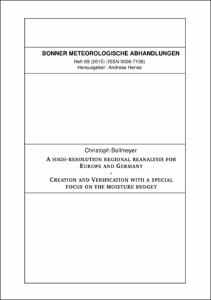Bollmeyer, Christoph: A high-resolution regional reanalysis for Europe and Germany : Creation and Verification with a special focus on the moisture budget. - Bonn, 2015. - Dissertation, Rheinische Friedrich-Wilhelms-Universität Bonn.
Online-Ausgabe in bonndoc: https://nbn-resolving.org/urn:nbn:de:hbz:5n-41525
Online-Ausgabe in bonndoc: https://nbn-resolving.org/urn:nbn:de:hbz:5n-41525
@phdthesis{handle:20.500.11811/6545,
urn: https://nbn-resolving.org/urn:nbn:de:hbz:5n-41525,
author = {{Christoph Bollmeyer}},
title = {A high-resolution regional reanalysis for Europe and Germany : Creation and Verification with a special focus on the moisture budget},
school = {Rheinische Friedrich-Wilhelms-Universität Bonn},
year = 2015,
month = oct,
volume = 69,
note = {Atmospheric reanalyses represent a state-of-the-art description of the Earth‘s atmospheric state over the past years or decades. They are comprised of a numerical model for the solution of the equations of motion describing the atmosphere and of a data assimilation system for the use of observational data within the system in order to keep the reanalysis as close to the observed atmospheric state as possible. Several large reanalysis data sets exist, created by the largest meteorological centres and research institutes. Most of them, however, are global reanalyses spanning several decades or even the whole 20th century and are thus of a relatively coarse horizontal resolution of 40 to 120 km and temporal resolution of 3 to 6 hours. Those reanalyses are well suited for studying the global climate conditions and the climate change but are ineligible for regional studies on much smaller domains since they are unable to resolve small scale features in the model domains. When studying the impact of climate change on small domains, e.g. only for Germany, the coupling of atmosphere and surface or sub-surface models or local atmospheric and hydrological features, data sets with a high resolution are needed.
Therefore, the main focus of this work is on developing and operating two high-resolution regional reanalyses for two domains: the first covering Europe at a horizontal resolution of 6 km and the second covering Germany and surrounding states at a horizontal resolution of 2 km, both with a temporal resolution of one hour and less. The setup of the complete system driving the reanalysis is described along with the models behind it. The two models are evaluated against independent observations and the superiority of the regional reanalyses against a global reanalysis and a dynamical downscaling is shown.
A special focus in the verification of the reanalysis for Europe is on the moisture budget, which comprises the divergence of the horizontal moisture transports and the vertically integrated moisture flux divergence. On average time scales of a year, the moisture transport should balance the moisture flux divergence in the reanalysis, which is not the case. An approach for the modification of the moisture transports and flux divergence in a consistent way to fulfill this fundamental balance using finite elements is proposed. The method and consecutive results are presented and discussed.},
url = {https://hdl.handle.net/20.500.11811/6545}
}
urn: https://nbn-resolving.org/urn:nbn:de:hbz:5n-41525,
author = {{Christoph Bollmeyer}},
title = {A high-resolution regional reanalysis for Europe and Germany : Creation and Verification with a special focus on the moisture budget},
school = {Rheinische Friedrich-Wilhelms-Universität Bonn},
year = 2015,
month = oct,
volume = 69,
note = {Atmospheric reanalyses represent a state-of-the-art description of the Earth‘s atmospheric state over the past years or decades. They are comprised of a numerical model for the solution of the equations of motion describing the atmosphere and of a data assimilation system for the use of observational data within the system in order to keep the reanalysis as close to the observed atmospheric state as possible. Several large reanalysis data sets exist, created by the largest meteorological centres and research institutes. Most of them, however, are global reanalyses spanning several decades or even the whole 20th century and are thus of a relatively coarse horizontal resolution of 40 to 120 km and temporal resolution of 3 to 6 hours. Those reanalyses are well suited for studying the global climate conditions and the climate change but are ineligible for regional studies on much smaller domains since they are unable to resolve small scale features in the model domains. When studying the impact of climate change on small domains, e.g. only for Germany, the coupling of atmosphere and surface or sub-surface models or local atmospheric and hydrological features, data sets with a high resolution are needed.
Therefore, the main focus of this work is on developing and operating two high-resolution regional reanalyses for two domains: the first covering Europe at a horizontal resolution of 6 km and the second covering Germany and surrounding states at a horizontal resolution of 2 km, both with a temporal resolution of one hour and less. The setup of the complete system driving the reanalysis is described along with the models behind it. The two models are evaluated against independent observations and the superiority of the regional reanalyses against a global reanalysis and a dynamical downscaling is shown.
A special focus in the verification of the reanalysis for Europe is on the moisture budget, which comprises the divergence of the horizontal moisture transports and the vertically integrated moisture flux divergence. On average time scales of a year, the moisture transport should balance the moisture flux divergence in the reanalysis, which is not the case. An approach for the modification of the moisture transports and flux divergence in a consistent way to fulfill this fundamental balance using finite elements is proposed. The method and consecutive results are presented and discussed.},
url = {https://hdl.handle.net/20.500.11811/6545}
}






